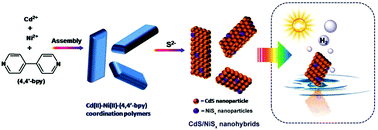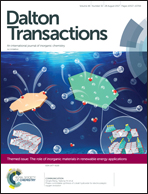Self-template synthesis of CdS/NiSx heterostructured nanohybrids for efficient photocatalytic hydrogen evolution†
Abstract
Photocatalytic hydrogen (H2) evolution from water splitting is attracting enormous interest due to the possibility of converting solar energy into green chemical energy. The construction of highly efficient and stable photocatalysts is of importance and necessary for the development of photocatalytic water splitting technology. In this study, we have developed a self-template synthetic strategy for the preparation of heterostructured nanohybrids composed of ultrasmall CdS and NiSx nanoparticles by using Cd(II)–Ni(II)-(4,4′-bipyridine) coordination polymers as the precursor and template. The CdS/NiSx nanohybrids are comprised of integrated CdS and NiSx nanoclusters in a heterostructure which function as highly efficient visible-light-driven H2 evolution photocatalysts. The enhanced photocatalytic performance could be attributed to the formation of hetero-junctions between CdS and NiSx nanoparticles inside the nanohybrids which could effectively improve the separation efficiency of photogenerated electrons and holes, and thus enhance the photocatalytic activity. This work can provide a new insight into the design and fabrication of other heterostructured photocatalysts for solar-driven water splitting or other photocatalytic applications.

- This article is part of the themed collection: The Role of Inorganic Materials in Renewable Energy Applications


 Please wait while we load your content...
Please wait while we load your content...